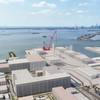New Tools Help Port Management
BMT Asia Pacific (BMT) has launched two comprehensive tools for assessing port competition and managing commercial risk.
The Port Choice Model and Port 360° evaluate the competitive advantage of a given port within its environment. Developed by BMT following years of academic research and professional consultancy assisting governments and stakeholders, the tools uniquely apply both quantitative and qualitative methodology and measure a spectrum of criteria, defined by leading economists and technical port experts.
With the growing complexity of the port sector, BMT recognized the need to assess competition with greater, critical scrutiny. Typical market share studies draw on historical market share data, distance, or travel time estimates, but BMT’s assessment tools are designed to take analyses a few steps further.
“What investors need to know today is how the distribution dynamics of cargo – from ocean to hinterland – will impact future profits,” noted Dr. Richard Colwill, Managing Director, BMT Asia Pacific. “Ultimately we are looking to help clients invest wisely, and in today’s dynamic investment market this has never been more important.”
The time and cost items of BMT’s Port Choice Model include trucking time and cost from factory to port, average waiting time in ports due to customs inspection and cargo handling, frequency of sailings, specifics on the terminal handling charges, ocean freight costs differentials, as well as a series of other appropriate factors. This detailed analysis can give very specific results.
Dr. Simon Su, Director and Chief Economist, BMT Asia Pacific, explained, “Using the Port Choice Model we can more accurately predict how cargo owners and shippers choose their ports and the value they place on each of these factors, including intangible costs.”
The Port 360° tool, which reviews the competitive strengths of ports or between terminals within the same port, completes the picture of competitiveness and can be used in isolation when time or availability of data are limited. Port 360° reviews 12 criteria relating to four aspects of a port: Demand (cargo throughput), Physical Attributes, Hinterland Connectivity, and Management and Operating Systems.
Dr. Colwill concluded, “Port competition is fierce and operators and investors need a robust and reliable approach to measuring competition and addressing the possible outcomes as a result of changes in the market. We are very pleased to be introducing two new tools which further enable us to communicate our specialised knowledge to customers in a coherent and meaningful way.”











